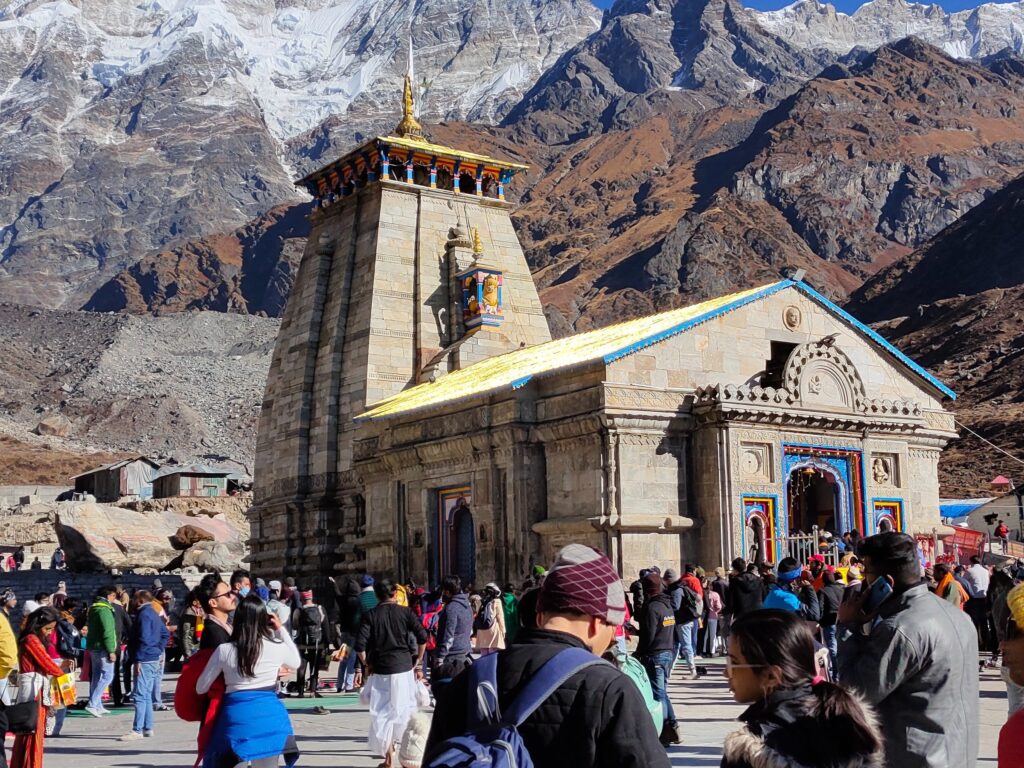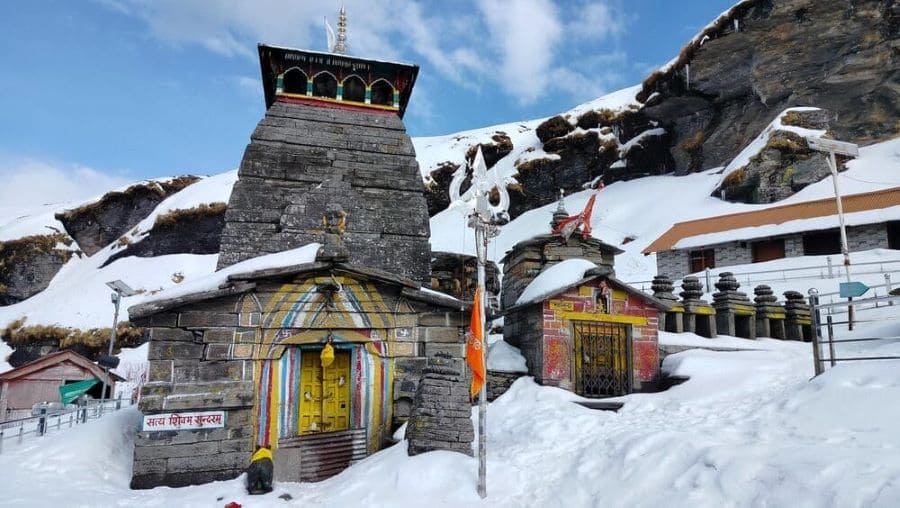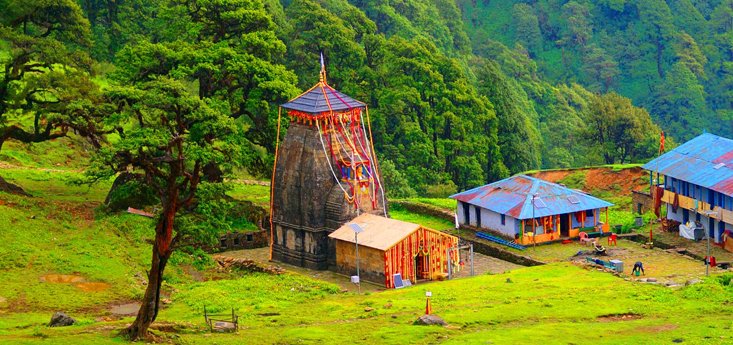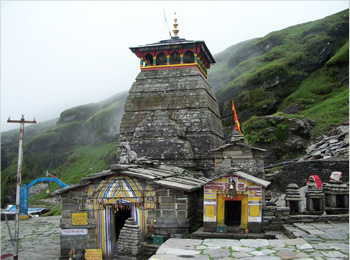Scattered throughout Uttarakhand are numerous temples devoted to various Hindu deities. In the Garhwal region of the state lie five revered shrines where Lord Shiva is venerated, collectively known as Panch Kedar (meaning 'five' in Hindi). These temples include Kedarnath, Madhmaheshwar, Tungnath, Rudranath, and Kalpnath. Legends surrounding the origins of these sites vary. Still, according to popular belief, during a bygone era recounted in ancient Hindu scriptures, the Pandava princes from the epic Mahabharata were advised to seek penance by worshipping Lord Shiva in Uttarakhand due to the bloodshed of the war. It is said that Lord Shiva, disguised as a buffalo, sought refuge from the Pandavas but was identified by Bhima, one of the five brothers. Upon recognition, the deity vanished and reappeared in five distinct locations in the Himalayas. Each of these sites is believed to represent a specific aspect of Lord Shiva - Kedarnath (symbolizing his hump), Madhmaheshwar (depicting his belly button), Tungnath (representing his arms), Rudranath (symbolizing his face), and Kalpeshwar (representing his jata or hair). Here are a few facts about each of them.
Kedarnath
- Location: Kedarnath is situated in the Rudraprayag district of Uttarakhand, India, nestled in the Garhwal Himalayas.
- Altitude: It is located at a high altitude of about 3,583 meters (11,755 feet) above sea level.
- Pilgrimage Importance: Kedarnath is one of the Char Dham pilgrimage sites and is also a part of the Panch Kedar circuit, which includes four other temples dedicated to Lord Shiva.
- Kedarnath Temple: The main attraction of Kedarnath is the Kedarnath Temple, which is believed to have been built by the Pandavas, the legendary figures from the Hindu epic Mahabharata. The temple is made of large, heavy slabs of stone and is situated near the Mandakini River.
- Jyotirlinga: Kedarnath is considered one of the twelve Jyotirlingas, which are the holiest Shiva temples in Hinduism. It represents the form of Lord Shiva known as "Jyotirlinga," meaning the radiant light of Lord Shiva.
- Accessibility: Due to its high altitude, Kedarnath is accessible only for a few months each year during the summer season. The temple remains closed during the winter months due to heavy snowfall and harsh weather conditions.
- Natural Beauty: Apart from its religious significance, Kedarnath is renowned for its stunning natural beauty, surrounded by snow-capped peaks and lush greenery.
- 2013 Flash Floods: In June 2013, Kedarnath and its surrounding areas were severely affected by devastating flash floods and landslides, resulting in significant loss of life and infrastructure damage. However, efforts have been made for restoration and reconstruction since then.
- Reconstruction: After the 2013 disaster, significant efforts have been made to rebuild and rehabilitate the pilgrimage site, including the reconstruction of damaged infrastructure and the revival of tourism.
- Devotee Footfall: Despite the challenges posed by its remote location and seasonal accessibility, Kedarnath continues to attract a large number of devotees and tourists every year, drawn by its spiritual significance and natural beauty.

Tugnath
Here are some facts about Tungnath:
- Location: Tungnath is located in the Rudraprayag district of Uttarakhand, India. It is situated in the Garhwal Himalayas at an altitude of approximately 3,680 meters (12,073 feet) above sea level. It is the highest shiva temple.
- Pilgrimage Importance: Tungnath is considered one of the Panch Kedar, the five sacred temples dedicated to Lord Shiva in the Garhwal region. It is the highest of the Panch Kedar temples.
- Tungnath Temple: The main attraction of Tungnath is the Tungnath Temple, which is believed to be more than 1000 years old. It is constructed in the traditional North Indian architectural style and is made of stone and wood.
- Legends: According to Hindu mythology, Tungnath is associated with the Mahabharata epic. It is believed that after the Kurukshetra war, the Pandava brothers sought forgiveness from Lord Shiva for the sins committed during the war. Lord Shiva, however, didn't want to forgive them and took the form of a bull. The Pandavas tried to find him but could only locate his body parts. The arms were found at Tungnath.
- Accessibility: Tungnath is accessible via a trekking trail from Chopta, which is the nearest roadhead. The trek is about 3.5 kilometers long and is of moderate difficulty.
- Trekking Destination: Apart from its religious significance, Tungnath is also a popular trekking destination. The trek to Tungnath offers breathtaking views of the Himalayan peaks and lush greenery.
- Open Season: Similar to other high-altitude pilgrimage sites in the region, Tungnath remains open to devotees and tourists during the summer months, typically from April to November. It remains closed during the winter due to heavy snowfall and extreme weather conditions.
- Natural Beauty: Tungnath is surrounded by scenic beauty, with panoramic views of snow-capped peaks and alpine meadows, making it a serene and picturesque destination for nature lovers and spiritual seekers alike.

Rudranath
Here are some facts about Rudranath:
- Location: Rudranath is situated in the Chamoli district of Uttarakhand, India. It is part of the Panch Kedar circuit and is located at an altitude of approximately 3,600 meters (11,811 feet) above sea level.
- Pilgrimage Importance: Rudranath is one of the Panch Kedar temples dedicated to Lord Shiva. It holds significant religious importance for Hindus and is visited by pilgrims seeking the blessings of Lord Shiva.
- Rudranath Temple: The main attraction of Rudranath is the Rudranath Temple, which is believed to be ancient and of considerable historical significance. The temple is made of stone and is nestled amidst picturesque surroundings.
- Legends: According to Hindu mythology, Rudranath is associated with the Mahabharata epic. It is said that after the Kurukshetra war, the Pandava brothers sought forgiveness from Lord Shiva for the sins committed during the war. Lord Shiva, disguised as a bull, scattered his body parts across the Himalayas. The face of Lord Shiva is believed to have appeared at Rudranath.
- Accessibility: Rudranath is accessible via a trekking trail from Sagar Village, which is the nearest roadhead. The trek is approximately 20 kilometers long and passes through scenic landscapes, forests, and meadows.
- Trekking Destination: Rudranath is a popular trekking destination, attracting adventure enthusiasts and nature lovers. The trek offers stunning views of the Himalayan peaks, dense forests, and alpine meadows.
- Natural Beauty: Rudranath is surrounded by pristine natural beauty, with snow-capped mountains, lush greenery, and serene landscapes. It provides a tranquil and spiritual atmosphere for visitors seeking solace and inner peace.
- Cultural Significance: Rudranath is not only a religious site but also a cultural hub, where local traditions, rituals, and festivities are celebrated with fervor. The temple serves as a focal point for community gatherings and religious ceremonies.
- Seasonal Access: Similar to other high-altitude pilgrimage sites, Rudranath remains accessible to pilgrims and tourists during the summer months, typically from April to November. It remains closed during the winter due to heavy snowfall and harsh weather conditions.

Madhyameshwar
Here are some facts about Madhmaheshwar:
- Location: Madhmaheshwar is situated in the Rudraprayag district of Uttarakhand, India. It is part of the Panch Kedar circuit and is located at an altitude of approximately 3,289 meters (10,791 feet) above sea level.
- Pilgrimage Importance: Madhmaheshwar is revered as one of the Panch Kedar temples dedicated to Lord Shiva. It holds significant religious significance for Hindus and is visited by pilgrims seeking spiritual blessings.
- Madhmaheshwar Temple: The main attraction of Madhmaheshwar is the Madhmaheshwar Temple, which is believed to be ancient and holds architectural and historical importance. The temple is constructed in the traditional North Indian style and is adorned with intricate carvings.
- Legends: According to Hindu mythology, Madhmaheshwar is associated with the Mahabharata epic. It is said that after the Kurukshetra war, the Pandava brothers sought forgiveness from Lord Shiva for their sins. Lord Shiva, disguised as a bull, scattered his body parts across the Himalayas. The navel of Lord Shiva is believed to have appeared at Madhmaheshwar.
- Accessibility: Madhmaheshwar is accessible via a trekking trail from Ukhimath, which is the nearest roadhead. The trek is approximately 21 kilometers long and offers breathtaking views of the surrounding mountains, valleys, and forests.
- Trekking Destination: Madhmaheshwar is a popular trekking destination, attracting adventure enthusiasts and nature lovers. The trek to Madhmaheshwar is known for its scenic beauty, diverse flora and fauna, and challenging terrain.
- Natural Beauty: Madhmaheshwar is surrounded by pristine natural beauty, with snow-capped peaks, lush green meadows, and gushing streams. It provides a serene and tranquil environment for pilgrims and tourists alike.
- Cultural Significance: Madhmaheshwar is not only a religious site but also a cultural hub, where local traditions, rituals, and festivals are celebrated with enthusiasm. The temple serves as a center for spiritual gatherings and religious ceremonies.
- Seasonal Access: Similar to other high-altitude pilgrimage sites, Madhmaheshwar remains accessible during the summer months, typically from April to November. It remains closed during the winter due to heavy snowfall and extreme weather conditions.

Kalpeshwar
Here are some facts about Kalpeshwar:
- Location: Kalpeshwar is located in the Chamoli district of Uttarakhand, India. It is part of the Panch Kedar circuit and is approximately 2,200 meters (7,218 feet) above sea level.
- Pilgrimage Importance: Kalpeshwar is revered as one of the Panch Kedar temples dedicated to Lord Shiva. It holds significant religious significance for Hindus and is visited by devotees seeking spiritual blessings.
- Kalpeshwar Temple: The main attraction of Kalpeshwar is the Kalpeshwar Temple, which is dedicated to Lord Shiva. The temple is small and simple in structure, nestled amidst picturesque surroundings.
- Legends: According to Hindu mythology, Kalpeshwar is associated with the Mahabharata epic. It is said that after the Kurukshetra war, the Pandava brothers sought forgiveness from Lord Shiva for their sins. Lord Shiva, disguised as a bull, scattered his body parts across the Himalayas. The matted locks or hair of Lord Shiva are believed to have appeared at Kalpeshwar.
- Accessibility: Kalpeshwar is accessible via a trekking trail from Helang, which is the nearest roadhead. The trek is approximately 12 kilometers long and passes through scenic landscapes, forests, and villages.
- Trekking Destination: Kalpeshwar is a popular trekking destination, attracting adventure enthusiasts and nature lovers. The trek to Kalpeshwar offers stunning views of the surrounding mountains, valleys, and streams.
- Natural Beauty: Kalpeshwar is surrounded by pristine natural beauty, with lush greenery, cascading waterfalls, and serene landscapes. It provides a tranquil and peaceful atmosphere for pilgrims and tourists alike.
- Cultural Significance: Kalpeshwar is not only a religious site but also a cultural center, where local traditions, rituals, and festivals are celebrated with enthusiasm. The temple serves as a gathering place for spiritual gatherings and religious ceremonies.
- Entire year access: Kalpeshwar is the only one of the panch kedar which is worshipped throughout the year.
